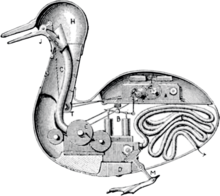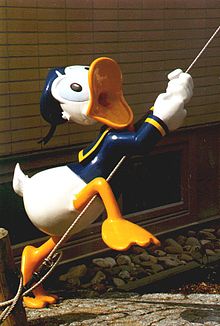Ducks
| Ducks | ||||||||||
|---|---|---|---|---|---|---|---|---|---|---|

Mallard -pair ( Anas platyrhynchos ) |
||||||||||
| Systematics | ||||||||||
|
||||||||||
| Scientific name | ||||||||||
| Anatidae | ||||||||||
| Vigors , 1825 |
The family of the duck birds (Anatidae) is the most species-rich of the order of the goose birds (Anseriformes). It comprises 47 genera and around 150 species . This group includes such well-known types of waterfowl as ducks, geese and swans . Perhaps apart from the chickens , no other group of birds has so numerous interrelationships with humans: five species alone have been domesticated . Ducks are hunted and kept for their meat, eggs and feathers, and in many forms they have found their way into fairy tales, sagas and comics. Linguistically, the terms duck denote the female and drake or drake the male bird. The most noticeable distinguishing feature is the more colorful splendor of the male ducks, the drakes (see appearance of adult mallards ).
features
All duck birds are more or less adapted to an aquatic life. Their long, broad body gives them buoyancy while swimming, their feet are webbed (exception: Hawaiian gans ) and start far behind the body. This makes walking on land look a bit clumsy, but duckbirds are not nearly as clumsy when walking as many seabirds. The neck is often noticeably long - especially in geese and swans, but also in some ducks.

The size of the duck birds ranges from 30 cm ( dwarf ducks ) to 180 cm ( trumpeter swan ), the weight is between 230 g and 22.5 kg. The wingspan of a trumpeter swan can be 240 cm. The plumage is very dense and is regularly oiled with the secretion of the well-developed rump gland to make it water-repellent. Many duck birds are extremely colorful. This is particularly true of the ducks of the subfamily Anatinae , which often have brightly colored plumage, while white, brown and gray basic colors predominate in the geese. Mostly there is a pronounced sexual dimorphism , in which the males are beautifully colored, but the females are inconspicuously gray-brown. At the end of the breeding season, duck birds go through a moult , during which they are briefly unable to fly and in which males with the so-called plain dress often temporarily match the color of the females. The youth plumage mostly resembles the female plumage. A notable exception to the usual coloring scheme is the Paradise Kasarka , which is the only duck bird to have an inverted sex dimorphism with more colorful females.
All duck birds have salt glands above the eyes , through which the ingested salt can be excreted. The high-beaked profile of marine species such as the eider ducks can be explained by the fact that the excreted salt should be better drained through the beak.
Duck birds have a relatively wide beak , the edges of which are lamellar. A mallard's bill has 36 to 54 lamellae on the top and 72 to 80 lamellae on the underside. In the duck birds, which feed on microorganisms, the lamellae serve as a filter device. Water is sucked in through the half-open beak, which is then pressed out through the slats. Often there are modifications of the original lamellar structure, for example in the case of the saws , in which the lamellae are transformed into small teeth that make it easier to hold the fish prey. The beak of the duck birds is often brightly colored, especially in males in the breeding dress it takes on bright colors. The upper beak has a horny tip. It is densely populated with tactile cells.
The wings of the duck birds are short and strong. Because of the relatively high weight of the birds and the small wing area, permanent wing flapping is required and no gliding phases are possible. In order to rise into the air, especially the larger species have to walk a few meters on the surface of the water. Once in the air, ducks can cover long distances, sometimes at altitudes of up to 8000 m. An exception are three types of steamboat ducks , which have become completely flightless.
The tail is usually very short and square, sometimes also slightly rounded. Only rowing ducks are relatively long-tailed. The most important function of the tail is to control it in flight.
Duck birds swim with alternating flaps of their feet. All ducks can also dive, although they use this ability to very different degrees. Some only do it in emergencies, others like diving ducks, sea ducks and rowing ducks when they forage on a daily basis.
When looking at the internal organs, the enlarged heart of often diving ducks is noticeable. The gizzard is enlarged in the geese in order to be able to chop up the fibrous plants; an even greater magnification can be found in sea ducks that take up mollusc shells . The herbivores among the ducks also have large appendices .
Most ducks are very vocal. The quacking of the swimming ducks is known here . Only female ducks croak, while males make other sounds, for example thin whistles. Geese are known for their loud chatter, whistling geese and half geese mostly for whistling sounds. The calls of the swans can carry the farthest. The trumpeter swan has bubble-shaped resonance chambers ( bullae ) on the vocal head and along the trachea , which enormously increase the volume of the screams. The rowing ducks alone are not very vocal and, apart from hissing and grunting tones, almost mute.
distribution and habitat
Duck birds are common on all continents with the exception of Antarctica . They occur in all climatic zones from the high arctic tundra to the tropical rainforests. They can be found in all types of aquatic habitats. Most species breed in fresh water and only come to the sea by migration and in winter; this is true even for most of the so-called sea ducks. With the ruddy shelduck and the Bar-headed Goose , there are two species that are found even in 5000 m altitude in the mountains themselves.
While tropical and subtropical species are mostly resident birds , many ducks of the temperate and especially the polar and sub- polar zones undertake extensive migrations. The migrations of the Arctic geese, which travel several thousand kilometers to reach their winter quarters, are particularly well known .
Way of life
There are both diurnal and nocturnal species among the ducks. Most, however, are not set and are especially active at dusk. Duck birds often sleep on the water with their heads tucked under a wing. They spend a large part of the day caring for the plumage, which is regularly oiled with the secretion from the rump gland. Even the non-diving species regularly wet their plumage with water by flapping their wings violently on the surface of the water.
While few species breed in colonies, ducks are often found in large groups outside of the breeding season. These can also include several species - so swimming ducks and diving ducks often mix with other species of the same tribe . Only three species are strictly solitary: the hem-billed duck , the blue-winged goose, and the common brook duck .
nutrition
Very different diet types have developed among the duck birds, so that hardly anything can be said in common. Geese and swans are mainly herbivorous . With the swans, the long neck is used to reach the bottom of the water and to get to aquatic plants there. Adult geese mostly look for grass, seeds, herbs and mosses in the country - their young, on the other hand, are often insect and crustacean eaters . Also tadorninae are mostly herbivores, some even exclusively.

The swimming ducks dig in shallow water with the help of their beak blades. They search the bottom sludge for water insects, crustaceans and parts of plants. In the shoveler , the lamellar apparatus is so refined that it has become a plankton filter. Diving ducks and rowing ducks also dig, but mostly they dive to the bottom. There they mainly eat aquatic plants, sometimes also insects and crustaceans. Among the sea ducks and sawsaws there are also many representatives who dive for small animals. The hunters are specialized fish hunters, the eider ducks mainly eat mollusks .
The daily food requirement of the duck birds is around ten percent of their own weight. The herbivores also ingest sand and small stones to help the gizzard break up food that is difficult to digest ( gastroliths ).
Some ducks also act as kleptoparasites . Gadgets are occasionally seen attacking coots that have been robbed of their food. Likewise attack wigeon in the same intention diving ducks. Most of the time, duck birds are victims of kleptoparasitism, especially from seagulls .
Ducks that live in close contact with humans, e.g. B. in a city park, often feed on what people feed them. They are not particularly picky and also eat sausage or cheese. However, bread in particular is harmful to animals and their environment. For one thing, the animals only eat “sweets” with little nutritional value in large quantities. On the other hand, there is an oversupply of food, which leads to overpopulation in the area concerned. Bread that is not eaten can also quickly mold and stink, which reduces the quality of the habitat .
Reproduction
Most ducks do not breed in colonies. Exceptions here are above all the geese of the tundra, as colonies in a wide, open landscape still offer the best protection against predators. Colonies of duckbirds are rarely excessively large and typically comprise a few dozen to a hundred pairs.
Monogamy is the rule, and with the African rowing duck and the humped goose , only two species are known that deviate from it and live in polygamy . With most ducks, the individuals look for a new partner every breeding season. Geese and swans, on the other hand, mate for life. In a group of mute swans , it was found that 97% of the successfully breeding animals brooded with the same partner in the following year. A courtship ceremony , which is more complex for those species that mate each year, is part of the pairing process.
The female is usually responsible for building the nest . With swans and whistling geese the male is also involved, with koskorobaschwan and chicken goose the male builds the nest alone. The nest is seldom more than a depression in the ground covered with vegetation. The nest is often padded with down feathers from the breast, which the female plucks out for this. This simultaneously exposes the brood spot .
The nests of many swans, who build very large nests out of grass, aquatic plants and twigs, are somewhat more complex. Despite their size, these nests are difficult to locate as they resemble the surrounding vegetation. With the whistling geese, sawsaws and musk ducks there are also tree-nesting ducks. Goosander and golden-bellied ducks breed in tree hollows.
Four to thirteen eggs are laid, with swans and geese having the smallest and swimming and diving ducks the largest. The weight of the eggs is between 27 g (dwarf ducks) and 345 g (mute swan). It is incubated for a period of 22 to 40 days. The swans again have the longest breeding period here. The period is particularly short for swimming ducks, but also for arctic geese, which have to keep the time for breeding and rearing young as short as possible due to the extreme conditions of their habitat.
A notable exception is the South American cuckoo duck , which does not build its own nest, but lays its eggs in the nests of coots and other ducks. The young hatch after 21 days and only leave the nest one or two days later. You are immediately completely independent. In contrast to the eponymous cuckoo , they spare the eggs of the host, whose brood is thus not damaged. While the cuckoo duck is a mandatory breeding parasite that never builds its own nest, occasional intraspecific breeding parasitism occurs in several species.
Even with other ducks, the young are immediately able to run and swim. However, they will be accompanied by the parent birds for a few more weeks. In the case of the ducks, which form new pairs every year, the female alone takes on this task. In the case of lifelong monogamous species, both parent birds are responsible for care for the brood. The main role is to guide the young birds to feeding grounds and to guard them. Swans often carry the young on their backs. This support usually lasts four to ten weeks, but in some cases it can be considerably longer. Young geese sometimes accompany their parents on the train and stay with them in their winter quarters.
40 to 60% of ducks die before reaching sexual maturity, which in most species occurs after a year. Even after that, duck birds have a relatively low life expectancy. It is only two to three years for ducks and five years for geese. Swans have a longer life expectancy. However, these are only mean values that can also be exceeded by far. A mallard lived for 29 years, a gray goose for 26 years.
Tribal history
Duck birds have been known since the Oligocene , but fossils from this period are extremely rare. Explosive radiation did not occur until the Miocene . All major recent tribes are documented from the Miocene.
Some larger taxa are now completely extinct. The Presbyornithidae, Cnemiornithidae (New Zealand geese), Romainvillidae, Cygnopteridae and Paranyrocidae are not classified here with the duck birds, but as independent families parallel to them. The following fossil and sub-fossil taxa remain with the ducks:
- Dendrocheninae - The two species Mionetta and Dendrochen are known from the Miocene of North America and Europe, and were similar to recent Pfeifgänsen. Mionetta blanchardi probably nested on limestone cliffs in France, Dendray robusta on rivers of the subtropical savannas of South Dakota.
- Thambetochenini ( Moa-Nalos ) - A tribe of four species assigned to the geese that were endemic to the Hawaiian Islands . The large, flightless birds were wiped out by the Polynesian inhabitants of Hawaii before the Europeans arrived.
- Finsch's duck ( Chenonetta finschi ) was a flightless duck from New Zealand.
Systematics
Duck birds, together with the defensive birds , the cracked goose and some extinct taxa, make up the order of the geese birds . The relationship of these taxa is undisputed today and has been clearly proven in morphological and genetic analyzes. The duck birds are the sister group of the cracked goose, and both together are the sister group of the defensive birds.
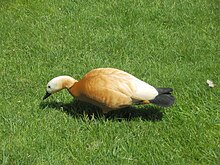
Traditionally, the family was divided into geese and ducks. The geese were also assigned the whistling geese and swans, the ducks also the half geese. In more recent systematics, the whistling geese are often given the status of their own subfamily, with Sibley and Monroe even their own family. The following system is based on Kear 2005 and also elevates monkey ducks, rowing ducks and demi-geese to the rank of subfamilies:
- Subfamily Whistling Geese (Dendrocygninae)
- Subfamily Dendrachtinae †
- Subfamily geese (Anserinae)
- Tribe swans (Cygnini)
- Tribe chicken geese (Cereopsini)
- Tribe real geese (Anserini)
- Tribe Moa-Nalos (Thambetochenini) †
- Subfamily monkey ducks (Stictonettinae)
- Subfamily rowing ducks (Oxyurinae)
- Subfamily demi-geese (Tadorninae)
- Tribus Merganettini (torrent, pack-billed ducks, steamship ducks)
- Tribus plectropterini (spur goose, humped goose)
- Tribus Tadornini (other half-geese)
- Subfamily Anatinae
- Tribus Malacorhynchini (Rose-eared, Salvadoriente)
- Tribe swimming ducks (Anatini)
- Tribe diving ducks (Aythyini)
- Tribus sea ducks and sawsmen (Mergini)
The musk duck ( Biziura lobata ) and the extinct Chatham Duck ( Pachyanas chathamica ) are " incertae sedis " d. That is, it cannot be assigned with any certainty to any of the taxa mentioned.
Often there is also a tribe of glossy ducks in systematics, which were assigned to the swimming ducks here.
The following cladogram is based on analyzes of mitochondrial DNA from 2002 , but it contradicts the systematics presented above:
| Ducks |
|
||||||||||||||||||||||||||||||||||||
|
|
Humans and ducks
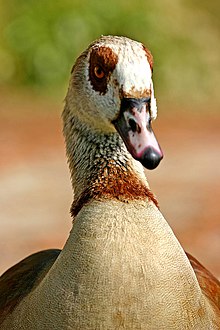

Besides the hen birds , the ducks are certainly the birds with the closest interactions with humans. Several species have been domesticated, appearing as characters in myths, fairy tales, operas, and comic strips, and their flesh, eggs, and feathers are used.
hunt
Duck birds have always been hunted for their meat. Spear hunting on pintail ducks is depicted on ancient Egyptian wall drawings . The difficulty of hunting flyable waterfowl without firearms led to the development of bait traps. The best known is the duck bunk , which was common until the beginning of the 20th century. Here a bait duck was used to lure the ducks into a trap . Often a trained dog was also involved, luring the ducks in. Here the hunters made use of the behavior of ducks to tackle a supposed enemy in a group. Today, such traps are rarely used. Hunting with firearms is still widely practiced, but more out of tradition than to meet food needs.
Domestication
Five species of duckbird have been domesticated by humans : the mallard, the gray goose, the swan goose, the musk duck, and the Egyptian goose. The Egyptian goose is the only one of these species that only occurs wild today.
Today's domestic geese are descended from two different species: the gray goose was domesticated in Europe and the swan goose in China . Domestication of geese was an obvious step. Similar to cattle, sheep, camels and reindeer, they mainly live on plants that humans could not use themselves. In Egypt it was already customary in the Old Kingdom to keep Egyptian geese. She played a role in the Egyptian creation myth and has also been with the god Geb associated. Even so, it was eaten regularly and stuffed like other geese in order to preserve the coveted fatty liver . After the conquest by the Persians (525 BC) there are no more mentions of Egyptian goose breeding.
The domestic duck comes from the mallard from the genus of the actual ducks . Domestication apparently occurred twice independently of one another: in Europe and South-East Asia. It is estimated that this happened about 3,000 years ago, significantly later than that of chickens and geese. While the so-called land ducks were bred in Europe, which also includes the Peking duck , which is still very similar in habit to the trunk form, but can be much heavier, in Asia a steep posture was bred out, which was originally also from Asia, probably Malaysia originating Indian Runner duck is seen. Land ducks are particularly suitable as meat suppliers, the penguin ducks, the collective term for ducks with a steep posture, are good egg layers. Duck farming is of secondary importance in Europe today, but not in East Asia, where ducks are among the most important livestock.
The musk duck was originally domesticated in Peru . The time can no longer be determined today, but it was long before the Spanish conquest. Their domestic form is the warty duck, which resembles the wild form except for its size and plumage color. In contrast to the vast majority of domestic duck breeds, which are descended from the mallard, it has retained its ability to fly, which is why it is also called "flight duck. The name "warty duck" comes from the wart-like bulges that sit on the base of the beak on the top of the head.
In addition to these duck birds, which have actually become pets, there are numerous semi-domesticated species that have been introduced worldwide as park birds. This has the consequence that duck birds spread outside their original range. The best-known example is the mute swan , which was introduced in Central Europe in the 16th century and is today considered "the swan" per se; later it was also introduced in North America, Australia and New Zealand. The black mourning swan , a native bird of Australia, has also made its home as a park bird in some regions of Europe, and in New Zealand it reproduced explosively after it was introduced by humans in the 19th century. Other examples of non-European ducks that are instantly native to parts of Europe that are mandarin duck , the Wood Duck , the Canada goose and the Egyptian goose .
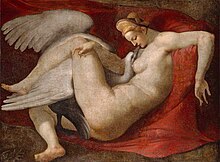
feathers
Duck bird feathers are used for several purposes. Today the most popular use is filling mattresses and pillows. The down of the eider ducks , which is particularly light and has a very heat-insulating effect, is particularly popular here . Usually, eiderdown is collected twice during a breeding season: once immediately after the nest has been built so that the ducks have to replace it, and then again after leaving the nest. Other important uses for a long time were the use as a quill pen and the fletching of arrows . Goose feathers were considered particularly suitable for both purposes.
Mythology, fairy tales, comics and technology
The popularity of the duck birds is also reflected in numerous myths, legends and fairy tales. In Celtic mythology , swans are often found who are, in truth, enchanted people. An example of this are the children of the Lir , who wandered around in swan form for 900 years. The motif is also taken up in the Lohengrin story, where the swan is the lost Duke of Brabant.
In Greek mythology , the swan motif also often found. So has God father Zeus of Leda approached in shape of a swan and her pregnant, then she laid two eggs from which sprang four children, among them also Helena . Another legend tells of Cyknos , Phaeton's lover . He was so heartbroken over the death of his friend that he wandered up and down the banks of the Eridanus for years until he was finally transported to the sky as a swan ( constellation Swan ).
In Buddhism the duck is seen as a symbol of the suppression of evil; This was processed, among others, by Hans Gál in his opera Die heilige Ente . In China , it is also a symbol of homosexuality and the penis in some parts of the country . The mandarin duck in particular stands for marital fidelity due to its distinctly monogamous way of life.
Geese are also often found in stories. Most famous are the events of the Celtic conquest of Rome (387 BC), when the cackling geese on the Capitol warned the citizens of the attackers. More recent is Selma Lagerlöf's story of Nils Holgersson and the wild geese .
The French automaton maker Jacques de Vaucanson designed, built and marketed a mechanical duck in the 18th century that is now considered his masterpiece. The Citroën 2CV is also known as the duck .
Walt Disney invented the fictional duckbirds most famous today . With Donald Duck , Gustav Gans and others, a whole race of ducks and geese inhabit the fictional city of Duckburg . Other well-known cartoon ducks include Daffy Duck , a Warner Bros. character , and Alfred Jodocus Kwak .
In the newspaper industry, a "duck" denotes both errors and deliberate false reports. The expression may come from French, where "give ducks" means "lie".
In fables , the duck is called Tybbke , which is supposed to represent the meaning "stupid, simple-minded, careless".
Threat and protection
33 species are on the IUCN Red List , which is a comparatively small proportion for a species-rich taxon with relatively large birds.
Several species are already extinct, including the Hawaiian Moa Nalos and the New Zealand demi-goose Euryanas finschi . The latter, like the New Zealand swan, has probably already been exterminated by the Maori . The ecological niche of the New Zealand swan has now been taken over by black swans imported from Australia.
Recently extinct or critically endangered are:
- the Labrador Duck ( Camptorhynchus labradorius ) bred in Labrador and wintered in New England . The species was eradicated by mass shooting in the wintering areas; the last specimen was shot near New York in 1875.
- The Auckland hawker ( Mergus australis ) was restricted to the sub-Antarctic Auckland Islands when it was discovered in 1840 , but fossil records show that it was also located on mainland New Zealand in historical times. Because, unlike other sawmills, it was almost flightless, it was an easy victim of human dogs, cats and rats on the Auckland Islands. The last time a specimen was seen was in 1902.
- the rose-headed duck ( Rhodonessa caryophyllacea ) was common in Assam , Myanmar and Bangladesh ; she has not been seen since 1949. The IUCN classifies them as critically endangered , as survival in inaccessible swamps of Myanmar is believed possible; In addition, there was another unverified report of a sighting of this species in 2003.
- the crested kasarka ( Tadorna cristata ) of East Asia has not been seen since 1964. Since there are repeatedly unverified reports of the species surviving in northeastern China, the IUCN still has it in a critically endangered state .
- the Madagascar bog duck ( Aythya innotata ) was thought to be extinct, but the species was rediscovered in 2006. The species is considered threatened with extinction because of the extremely small number of individuals in its population .
- the Campbell duck ( Anas nesiotis ) is also critically endangered. She only lives on Dent Island , a 23-acre island near Campbell Island . Apparently it was once more widespread and was able to survive on Dent, because only this island has been spared from introduced rats. Since accidental introduction of rats on Dent would likely result in rapid extinction, some specimens of the species were released on Codfish Island in 1999 .
- the darksawer ( Mergus octosetaceus ) still occurs in southern Brazil and northern Argentina with fewer than 250 individuals. This very territorial sawyer occupies large areas along the course of rapids-rich rivers and is dependent on clear water. Logging, the construction of hydropower plants and the mining of raw materials in its area of distribution have resulted in less and less suitable living space being available.
literature
- Janet Kear (Ed.): Ducks, Geese and Swans . Oxford University Press, 2005, ISBN 0-19-854645-9
- Josep del Hoyo et al. a .: Handbook of the Birds of the World. Volume 1: Ostrich to Ducks. Lynx Edicions, 1992, ISBN 84-87334-10-5 .
Web links
Individual evidence
Most of the information in this article has been taken from the sources given under literature; the following sources are also cited:
- ↑ Münster: Duck bread is duck death / system regulations prohibit feeding . Retrieved October 5, 2013.
- ^ Paul A. Johnsgard: The Avian Brood Parasites - Deception at the Nest . Oxford University Press, Oxford 1997, ISBN 0-19-511042-0 . P. 111-p. 114
- ^ Bradley C. Livezey: A phylogenetic analysis of basal Anseriformes, the fossil Presbyornis, and the interordinal relationships of waterfowl. In: Zoological Journal of the Linnean Society 1997, No. 121, pp. 361-428
- ^ Charles Sibley, Burt Monroe: Distribution and Taxonomy of the Birds of the World . Yale University Press, 1990. ISBN 0-300-04969-2
- ↑ Carole Donne-Goussé, Vincent Laudet, Catherine Hänni: A molecular phylogeny of anseriformes based on mitochondrial DNA analysis . In: Molecular Phylogenetics and Evolution 2002, Vol. 23, No. 3, pp. 339-356
- ↑ Janet Kear: Man and Wildfowl. T. & AD Poyser, London 1990, ISBN 0-85661-055-0 , p. 22 and p. 23
- ^ Wolfram Eberhard, Lexicon of Chinese Symbols, Munich 1983
- ^ Word growth: mythical animals and their properties, list of mythical animals
- ↑ Knowledge portal: fable names of animals
- ↑ Camptorhynchus labradorius in the IUCN Red List of Threatened Species . Retrieved November 12, 2008.
- ↑ Mergus australis in the IUCN Red List of Threatened Species . Retrieved November 12, 2008.
- ↑ Rhodonessa caryophyllacea in the IUCN Red List of Threatened Species . Retrieved November 12, 2008.
- ^ Tadorna cristata in the IUCN Red List of Threatened Species . Retrieved November 12, 2008.
- ↑ Aythya innotata in the IUCN Red List of Threatened Species . Retrieved November 12, 2008.
- ↑ Anas nesiotis in the IUCN Red List of Threatened Species . Retrieved November 12, 2008.
- ↑ Hartmut Kolbe; The duck birds in the world . Ulmer, 1999, ISBN 3-8001-7442-1 , pp. 316-317






